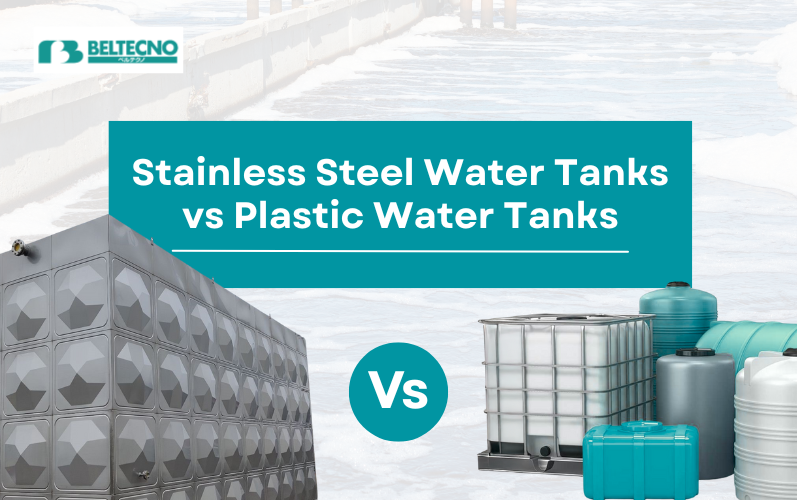Stainless Steel Water Tank vs Plastic: Which One Is Better?

Storing clean water isn’t just about capacity; it’s also about water quality, tank life, and the amount of maintenance a tank requires over time. If you’re comparing a stainless steel water tank vs a plastic one, the “best” choice depends on your usage (home, commercial, industrial), hygiene expectations, installation conditions, and total lifetime cost, not only purchase price.
This guide breaks down the differences between steel water tanks and plastic water tanks in terms of durability, corrosion/UV resistance, cleanliness, long-term value, and sustainability, so you can choose confidently.
Quick Decision
Choose a stainless steel water tank if you prioritise long service life, easier hygiene, and long-term value. Choose a plastic water tank if upfront budget and lightweight installation matter most, and the tank will be protected from harsh sun/conditions.

Stainless Steel Water Tank Vs Plastic: Key Differences
1) Durability & Lifespan
Stainless steel tanks are widely preferred for long-term structural reliability because steel resists UV-related degradation and stays rigid over time. Plastic tanks can be practical, but they’re more likely to degrade with prolonged UV exposure and harsh outdoor conditions, which can shorten usable life depending on quality and placement.
2) Hygiene & Water Quality
If water purity and cleaning ease are priorities, stainless steel’s smooth, non-porous surface is a major advantage because it’s easier to clean and less likely to harbour contaminants. Plastic tanks can work well, but users often need to be more attentive about cleaning schedules and storage conditions to maintain consistent water quality.
3) Corrosion/UV Resistance
Stainless steel is known for its corrosion resistance, which matters in humid environments, coastal regions, and industrial settings where moisture and chemicals may be present. Plastic tanks don’t “rust,” but they can weaken or age faster when constantly exposed to sun/heat, making location and shading important.
4) Maintenance Effort
Stainless steel tanks typically reduce maintenance hassle due to easier cleaning and long-term stability. Plastic tanks can be low-effort initially, but may require more frequent inspection for aging, discoloration, or surface wear depending on exposure and quality.
5) Upfront Cost Vs Lifetime Value
Plastic tanks usually win on initial price, which is why many buyers start there. Stainless steel tanks often justify the higher upfront cost with longer lifespan and reduced replacement frequency, which can lower the total cost of ownership over time.
6) Sustainability
Stainless steel is commonly positioned as a more sustainable choice because it is recyclable and typically lasts longer, reducing replacement cycles. Plastic tanks are lightweight and widely used, but end-of-life disposal and environmental impact are common concerns in sustainability-focused purchasing decisions.
Steel Water Tank Vs Plastic Water Tank: Which Is Best For Your Use Case?
For Homes (Everyday Water Storage)
A stainless steel tank is a strong fit if the household prioritises hygiene, long service life, and minimal long-term worry. A plastic tank can be a good fit for budget-led buying, especially when installed in a shaded/protected area and maintained well.
For Commercial Buildings & Institutions
Stainless steel tanks are commonly chosen where water quality standards, cleaning routines, and long-term reliability matter (e.g., hostels, schools, hospitals, food-related facilities). Plastic tanks may still be used in non-critical applications where cost and quick installation are the main drivers.
For Industrial Applications
Stainless steel tanks are often preferred in industrial environments due to durability, corrosion resistance, and sanitation expectations in many processes. Plastic tanks may be suitable for certain chemical compatibility needs depending on material grade and application, but long-term exposure conditions should be considered carefully.
Buyer Checklist: Choose The Right Tank Faster
Use this checklist before finalising:
- Placement: Will the tank sit in direct sun or harsh weather? (If yes, plastic requires extra care.)
- Water usage: Drinking/cooking vs general use, higher hygiene expectations push buyers toward stainless steel.
- Cleaning frequency: If regular cleaning is hard to maintain, stainless steel’s ease of cleaning helps.
- Lifecycle budget: Consider replacement cycles, not just initial purchase price.
- Compliance: Always verify local regulations/quality requirements for material and installation.
Stainless Steel Water Tank: Pros & Cons
Stainless steel water tanks are often chosen for long-term durability, hygiene-focused storage, and corrosion resistance, especially where reliability matters over years of use.

Stainless steel water tanks are often chosen for long-term durability, hygiene-focused storage, and corrosion resistance, especially where reliability matters over years of use.
Plastic Water Tank: Pros & Cons
Plastic water tanks are widely preferred for their lower upfront cost and lightweight, easy installation, making them a practical option for many homes and budget-led projects.
Cost Considerations And Long-Term Investment
Environmental Impact & Sustainability
Let's delve deeper into the environmental impact and sustainability considerations when comparing stainless steel and plastic water tanks.
FAQs
For those prioritizing long-term hygiene, durability, and lifecycle value, stainless steel is often the smarter upgrade over plastic for many homes, commercial sites, and industries. For product guidance or specification help, Contact Us.